Let me guess; you have an upcoming football match; your athletic events are nearing, or your final dance competition is on the doorstep which is going to decide your life, but you landed up with the pain on the posterior (back) of your heel or ankle. How disheartening it is, you won’t be able to perform at your expectations. You would be frustrated and distracted with the pain of the Achilles tendon.
“What’s wrong with my heel? What has happened? What should I do? Where should I go? How long it would take to get better?” A lot of questions must be running in your mind and feeling confused with what to do.
Well, all I can say is, you are at the right place. In this post, you will learn from the experts, everything about Achilles Tendinopathy and what you should do to treat it.
Achilles Tendon
The Achilles tendon is the strongest tendon in our body. It can hold 10X our bodyweight. It attaches the calf muscles to the heel bone so that we can perform activities like walk, run, jump, walk on toes, and hop.
Any pain, discomfort, and weakness of the Achilles tendon can limit us from doing such activities.
What is Achilles Tendinopathy?
Often referred to as Achilles Tendonitis, is an inflammation-like injury caused by tiny repetitive injuries to the Achilles tendon. Due to the repeated injuries to the tendon fibers, it leads to pain, swelling, and stiffness of the tendon, which interferes with our daily living activities.
Causes of Achilles Tendonitis
Repetitive use of the Achilles Tendon without subsequent rest, such as in Running, Jumping, Standing on Toes and Hopping are common causes. It is seen among Runners, Basketball Players, Gymnast, Athletes and Ballet dancers to name a few.
Wearing unappropriated shoes, calf muscle weakness, Biomechanical issues i.e. flat foot, over pronation and supination, and poor technique are all risk factors.

Clinical Features
Following are the clinical features and is seen around the affected Achilles Tendon.
1. Pain – Severe pain is felt at the beginning of the activities like running, jumping, hoping, then it tends to relive in the middle, followed by severe pain during after the activity and during rest.
2. Swelling – The surrounding of the affected area gets swollen, and in some cases, a severe tenderness is also felt.
3. Morning Stiffness – You will often feel extreme difficulty to place your first step when you get out of the bed. You will need to take few more steps to get slightly relieved finally. This situation is commonly described as Morning Stiffness.
4. Muscle Taut – The affected tendon will become hard, and it will be more prominent than the unaffected part. The hardness can be felt as if it has become rock solid upon palpating the muscle tendon. This is known as Muscle Taut, and it is a result of repetitive micro-traumas.
What do you need to do?
First of all, don’t panic. I know the stress and pressure that you are going through, but it won’t help. So take a deep breath, relax and book an appointment with a Physiotherapist or soft tissue therapist.
That’s right, Physiotherapy or soft tissue therapy is the right choice which will help you get back to be able to dance, run, walk and jump like you use to – and while you wait for your initial appointment remember Rest Ice Compress Elevate (RICE).

Following are the steps and on how we can help you with Achilles Tendinopathy.
1. Find out which has caused you the micro-trauma and we’ll help you to modify it. Typical things that we can do in clinic are, access your footwear, access your Biomechanics, offer advice on correction methods for your foot, the strength of the muscles, your running and jumping and movement techniques. Then your therapist will help you to modify the wrong method, advise you with footwear or orthotics that can help prevent re-injury to your Achilles Tendon.
2. Us a range of techniques of Soft Tissue Therapy and massage therapy to release any tension in the muscles attaching onto the Achilles Tendon which will help soften the muscles, remove the tension pulling force of the muscles on the Achilles, fasten the healing process and to soften the hard, taut Achilles Tendon.
3. Prescribe remedial strengthening and exercise to strengthen the weakened Achilles Tendon after Injury.
4. Provide stretching exercises, so that your flexibility of the muscle is not lost and does not impact your performance in daily living activities.
5. Provide corrective support such as, tapping or strapping to the injury to speed up your recovery.
Duration for Prognosis
Depending on your severity of the Achilles Tendinopathy, your lifestyle, how sooner you receive treatment from an expert, the period for prognosis will differ.
So what are you waiting for, get your Achilles Tendinopathy treated with one of our Qualified and well experience Therapists!





